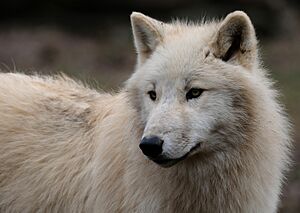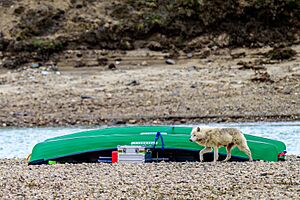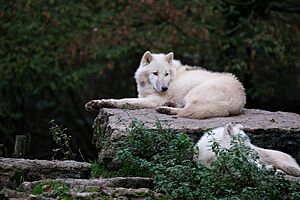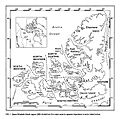Arctic wolf facts for kids
Quick facts for kids Arctic wolf |
|
|---|---|
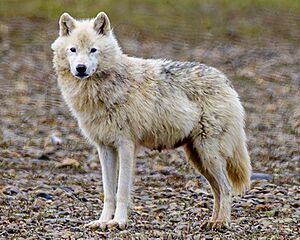 |
|
| This female Arctic wolf lives in Aulavik National Park, on Banks Island, NWT. | |
| Conservation status | |
|
Invalid status (COSEWIC)
|
|
| Scientific classification |
|
| Kingdom: | Animalia |
| Phylum: | Chordata |
| Class: | Mammalia |
| Order: | Carnivora |
| Family: | Canidae |
| Genus: | Canis |
| Species: | |
| Subspecies: |
C. l. arctos
|
| Trinomial name | |
| Canis lupus arctos Pocock, 1935
|
|
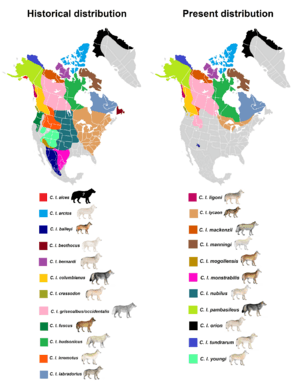 |
|
| This map shows where different grey wolf subspecies have lived in North America. | |
The Arctic wolf (Canis lupus arctos) is also called the white wolf or polar wolf. These amazing animals live in the very cold High Arctic tundra of Canada. You can find them on islands like Melville Island and Ellesmere Island.
Contents
What do Arctic Wolves Look Like?
They are a medium-sized wolf. They have whiter fur, a smaller head, and bigger teeth . Scientists have noticed that Arctic wolf skulls have become a bit smaller since 1930. This might be because they sometimes mix with domestic dogs.
Where Do Arctic Wolves Live?
Arctic wolves live in one of the coldest places on Earth. This area is called the High Arctic tundra. It includes Canada's Queen Elizabeth Islands. Their home stretches from Melville Island to Ellesmere Island. They also live on the northern edges of Prince of Wales and Somerset Islands.
Behavior
Arctic wolves are fascinating creatures. They live in packs, just like other wolves. Living in a pack helps them hunt large prey and survive the harsh Arctic conditions. They are known for being quite curious. They sometimes approach people, especially in areas where they don't see humans very often.
What's on the Menu?
Life in the Arctic means food can be hard to find. The main meals for an Arctic wolf are muskoxen and Arctic hares. Muskoxen are large, shaggy animals, so wolves often need to hunt them in packs.
They also eat smaller animals like lemmings, caribou, and even Arctic foxes if they get the chance. Birds and beetles can also be part of their diet. Sometimes, they have been seen looking for food in garbage left by people.
Are Arctic Wolves in Danger?
The good news is that the Arctic wolf is not considered endangered. Its population is listed as Least Concern. This is partly because its remote home is far away from most human activities.
However, they do face challenges from the environment. In 1997, the number of Arctic wolves, muskoxen, and Arctic hares dropped. This happened because of four years of very bad summer weather, which made it hard for their prey to survive.
Luckily, when the weather returned to normal the next summer, the animal populations recovered. This shows how much their survival is connected to the fragile Arctic climate.
Adaptations
Arctic wolves are perfectly adapted to their icy homes. They are specially built for life in extreme cold. Their thick white fur helps them blend in with the snow. This camouflage is very important for hunting and staying safe. These wolves are strong and smart predators. They have larger carnassial teeth compared to the northwestern wolf. This adaptation helps them crunch through frozen meat.
Interesting facts about the Arctic wolf
- Unlike some other wolves, Arctic wolves live in areas with no trees.
- A British scientist named Reginald Pocock gave the Arctic wolf its scientific name, Canis lupus arctos.
- Arctic wolves are often not very scared of people. They might approach people out of curiosity.
- Some studies using DNA have suggested that Arctic wolves might not be a separate subspecies. This is because their DNA is very similar to wolves from mainland North America. This could mean they moved to the Arctic islands more recently.
- Scientists don't know much about how Arctic wolves move around. This is mainly because they only migrate during the winter when it's dark for 24 hours a day. This makes it very hard to study them.
Images for kids
See also
 In Spanish: Lobo ártico para niños
In Spanish: Lobo ártico para niños


